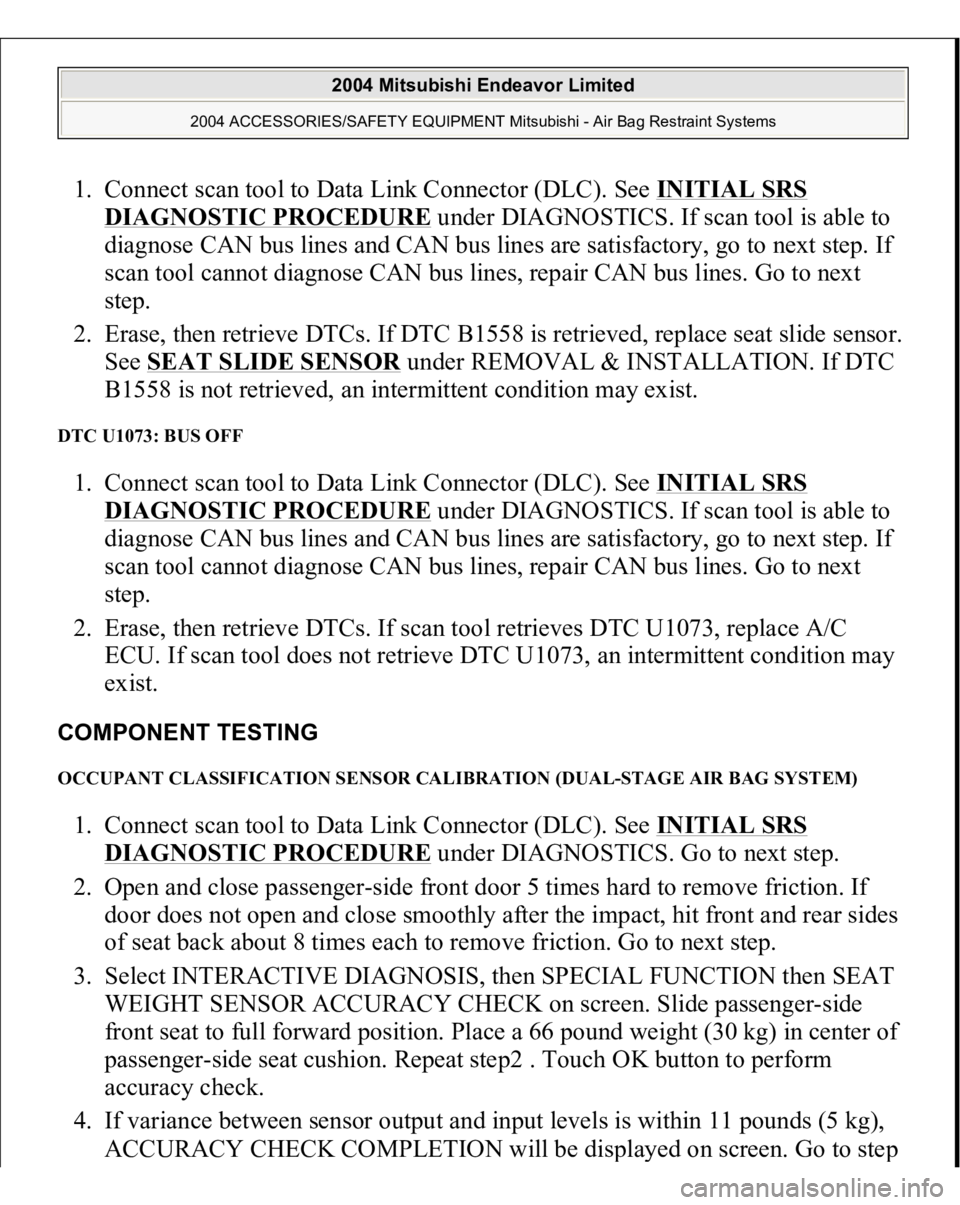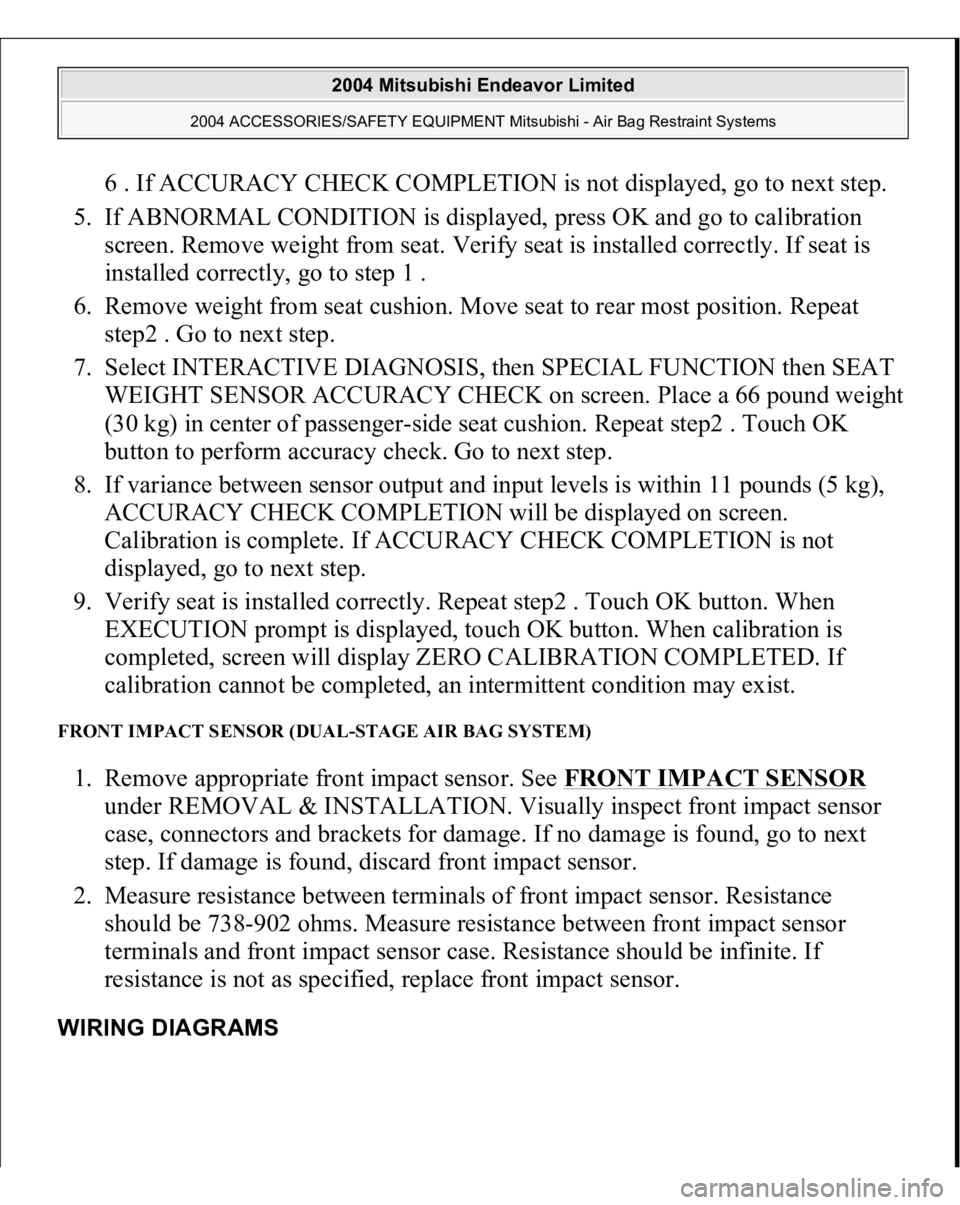Page 444 of 3870

1. Connect scan tool to Data Link Connector (DLC). See INITIAL SRS
DIAGNOSTIC PROCEDURE
under DIAGNOSTICS. If scan tool is able to
diagnose CAN bus lines and CAN bus lines are satisfactory, go to next step. If
scan tool cannot diagnose CAN bus lines, repair CAN bus lines. Go to next
step.
2. Erase, then retrieve DTCs. If DTC B1558 is retrieved, replace seat slide sensor.
See SEAT SLIDE SENSOR
under REMOVAL & INSTALLATION. If DTC
B1558 is not retrieved, an intermittent condition may exist.
DTC U1073: BUS OFF 1. Connect scan tool to Data Link Connector (DLC). See INITIAL SRS
DIAGNOSTIC PROCEDURE
under DIAGNOSTICS. If scan tool is able to
diagnose CAN bus lines and CAN bus lines are satisfactory, go to next step. If
scan tool cannot diagnose CAN bus lines, repair CAN bus lines. Go to next
step.
2. Erase, then retrieve DTCs. If scan tool retrieves DTC U1073, replace A/C
ECU. If scan tool does not retrieve DTC U1073, an intermittent condition may
exist.
COMPONENT TESTING OCCUPANT CLASSIFICATION SENSOR CALIBRATION (DUAL-STAGE AIR BAG SYSTEM) 1. Connect scan tool to Data Link Connector (DLC). See INITIAL SRS
DIAGNOSTIC PROCEDURE
under DIAGNOSTICS. Go to next step.
2. Open and close passenger-side front door 5 times hard to remove friction. If
door does not open and close smoothly after the impact, hit front and rear sides
of seat back about 8 times each to remove friction. Go to next step.
3. Select INTERACTIVE DIAGNOSIS, then SPECIAL FUNCTION then SEAT
WEIGHT SENSOR ACCURACY CHECK on screen. Slide passenger-side
front seat to full forward position. Place a 66 pound weight (30 kg) in center of
passenger-side seat cushion. Repeat step2 . Touch OK button to perform
accuracy check.
4. If variance between sensor output and input levels is within 11 pounds (5 kg),
ACCURACY CHECK COMPLETION will be dis
played on screen. Go to ste
p
2004 Mitsubishi Endeavor Limited
2004 ACCESSORIES/SAFETY EQUIPMENT Mitsubishi - Air Bag Restraint Systems
Page 445 of 3870

6 . If ACCURACY CHECK COMPLETION is not displayed, go to next step.
5. If ABNORMAL CONDITION is displayed, press OK and go to calibration
screen. Remove weight from seat. Verify seat is installed correctly. If seat is
installed correctly, go to step 1 .
6. Remove weight from seat cushion. Move seat to rear most position. Repeat
step2 . Go to next step.
7. Select INTERACTIVE DIAGNOSIS, then SPECIAL FUNCTION then SEAT
WEIGHT SENSOR ACCURACY CHECK on screen. Place a 66 pound weight
(30 kg) in center of passenger-side seat cushion. Repeat step2 . Touch OK
button to perform accuracy check. Go to next step.
8. If variance between sensor output and input levels is within 11 pounds (5 kg),
ACCURACY CHECK COMPLETION will be displayed on screen.
Calibration is complete. If ACCURACY CHECK COMPLETION is not
displayed, go to next step.
9. Verify seat is installed correctly. Repeat step2 . Touch OK button. When
EXECUTION prompt is displayed, touch OK button. When calibration is
completed, screen will display ZERO CALIBRATION COMPLETED. If
calibration cannot be completed, an intermittent condition may exist.
FRONT IMPACT SENSOR (DUAL-STAGE AIR BAG SYSTEM) 1. Remove appropriate front impact sensor. See FRONT IMPACT SENSOR
under REMOVAL & INSTALLATION. Visually inspect front impact sensor
case, connectors and brackets for damage. If no damage is found, go to next
step. If damage is found, discard front impact sensor.
2. Measure resistance between terminals of front impact sensor. Resistance
should be 738-902 ohms. Measure resistance between front impact sensor
terminals and front impact sensor case. Resistance should be infinite. If
resistance is not as specified, replace front impact sensor.
WIRING DIAGRAMS
2004 Mitsubishi Endeavor Limited
2004 ACCESSORIES/SAFETY EQUIPMENT Mitsubishi - Air Bag Restraint Systems
Page 675 of 3870
Fig. 2: Construction Diagram Of Front Axle (AWD)
Courtesy of MITSUBISHI MOTOR SALES OF AMERICA.
FRONT AXLE DIAGNOSIS TROUBLESHOOTING STRATEGY Use these steps to plan your diagnostic strategy. If you follow them carefully, you
will be sure that you have exhausted most of the possible ways to find a front axle
fault.
1. Gather information from the customer.
2. Verify that the condition described by the customer exists.
3. Find the malfunction by following the Symptom Chart. (See Fig. 3
)
4. Verify malfunction is eliminated.
SYMPTOM CHART
2004 Mitsubishi Endeavor LS
2004 DRIVELINE/AXLES Front Axle - Endeavor
Page 676 of 3870
Fig. 3: Drive Shaft Troubleshooting Symptom Chart
Courtesy of MITSUBISHI MOTOR SALES OF AMERICA.
SYMPTOM PROCEDURES INSPECTION PROCEDURE 1: Noise During Wheel Rotation DIAGNOSIS
STEP 1. Check the wheel bearing end play.
1. Remove the caliper assembly and suspend it with a wire.
2. Remove the brake disc from the front hub.
3. Attach a dial gauge as shown in the illustration, and then measure the end
play while moving the hub in the axial direction.
Limit: 0.05 mm (0.002 inch)
Q: Is the wheel bearing end play within the limit?
YES: Go to step 2.
NO: Replace the part, then go to Step
5.
2004 Mitsubishi Endeavor LS
2004 DRIVELINE/AXLES Front Axle - Endeavor
Page 678 of 3870
Q: Is the drive shaft assembly worn or damaged?
YES: Replace the drive shaft assembly. Then go to Step 5.
NO: There is no action to be taken.
STEP 5. Retest the system.
Q: Is the abnormal noise eliminated?
NO: Repeat to Step 1 .
YES: The procedure is complete.
INSPECTION PROCEDURE 2: Noise Due To Excessive Play Of Wheel In Turning Direction DIAGNOSIS
STEP 1. Check for play in the inner shaft and side gear serration, the
drive shaft and side gear serration, or the drive shaft and front hub
serration.
Q: Is the play found?
YES: Replace the part. Then go to Step 2.
NO: The procedure is complete.
STEP 2. Retest the system.
Q: Is the abnormal noise eliminated?
NO: Repeat to Step 1.
YES: The procedure is complete.
SPECIAL TOOLS
2004 Mitsubishi Endeavor LS
2004 DRIVELINE/AXLES Front Axle - Endeavor
Page 701 of 3870

2004 BRAKES
Basic Brake System - Endeavor
GENERAL DESCRIPTION The brake system has been designed to give greater reliability and durability and to
provide excellent braking performance. FEATURES IMPROVED BRAKING PERFORMANCE 1. A 9+10 inch tandem brake booster has been adopted to provide sufficient
braking force in sudden braking range.
2. Front ventilated disc brakes have been adopted to provide stabled braking force
and improved braking feel.
3. Rear solid disc brakes have been adopted. IMPROVED STABILITY 1. A 4-wheel anti-lock braking system (4ABS) has been adopted to prevent
slipping caused by the vehicle wheels locking up, in order to maintain a stable
vehicle posture and steering performance.
2. An electronic brake-force distribution (EBD) makes it possible to maintain the
maximum amount of braking force even when the vehicle's load is unevenly
distributed. < Vehicles with ABS>
3. A rear wheel early lock-prevention proportioning valve has been adopted. <
Vehicles without ABS>
4. Front- and rear-wheel X-type brake line layout has been adopted.
5. Ventilated discs have been adopted for front brakes in order to improve anti-
fading performance. IMPROVED SERVICEABILITY 1. A diagnosis function has been adopted for the ABS system in order to make
inspection easier.
2. An outer disc separated hub and rotor has been adopted to make removal and
2004 Mitsubishi Endeavor LS
2004 BRAKES Basic Brake System - Endeavor
2004 Mitsubishi Endeavor LS
2004 BRAKES Basic Brake System - Endeavor
Page 703 of 3870
Fig. 2: Identifying Vehicle Without ABS Brake
Courtesy of MITSUBISHI MOTOR SALES OF AMERICA.
BASIC BRAKE SYSTEM DIAGNOSIS INTRODUCTION TO BASIC BRAKE SYSTEM DIAGNOSIS Hydraulic brakes are composed of the brake pedal, master cylinder, brake booster
and disc brakes. Malfunctions such as insufficient braking power or the generation
of noise may occur due to wear, damage or incorrect adjustment of these
components. BASIC BRAKE SYSTEM DIAGNOSTIC TROUBLESHOOTING STRATEGY Use these steps to plan your diagnostic strategy. If you follow them carefully, you
will be sure that you have exhausted most of the possible ways to find a basic brake
system fault.
1. Gather information from the customer.
2. Verify that the condition described by the customer exists.
3. Find the malfunction by following the symptom chart.
4. Verif
y malfunction is eliminated.
2004 Mitsubishi Endeavor LS
2004 BRAKES Basic Brake System - Endeavor
Page 704 of 3870
SYMPTOM CHART Fig. 3: Symptom Chart
Courtesy of MITSUBISHI MOTOR SALES OF AMERICA.
SYMPTOM PROCEDURES INSPECTION PROCEDURE 1: VEHICLE PULLS TO ONE SIDE WHEN BRAKES ARE APPLIED DIAGNOSIS
STEP 1. Check for oil, water, etc., on the pad contact surface of all brakes.
Q: Is oil, water, etc., on the pad contact surface?
YES: Replace the part and determine the source/cause of foreign material.
Then go to Step 5 .
NO: Go to Step 2.
STEP 2. Check disc brake pistons for smooth operation.
1. With engine not running, depress the brake pedal rapidly several times to
deplete booster vacuum reserves.
2. Test each disc brake assembly one at a time.
a. Remove the lower caliper bolt, then remove caliper from mount.
b. Have an assistant slowly depress the brake pedal. Confirm piston(s)
extend slowl
y and smoothl
y with no
jum
piness. Re
peat for each disc
2004 Mitsubishi Endeavor LS
2004 BRAKES Basic Brake System - Endeavor